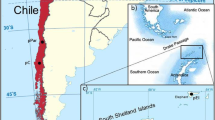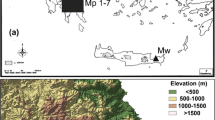Abstract
Genetic variation at 10 allozyme loci was analyzed in 14 populations of Polygala reinii (Polygalaceae), a perennial herb endemic to central Honshu, Japan, with a fragmented geographical distribution. The levels of genetic variation within species (P=80.0, A=3.10, HE=0.303) and within populations (P=42.1, A=1.61, HE=0.163) were considerably higher than the mean for other endemic plants or short-lived perennial herbs. Genetic differentiation among populations was also high (GST=0.404). The genetic distance phenogram tended to show a clustering of the populations reflecting the fragmentation of the species range. A principal component analysis revealed the same tendency, as well as three groupings of populations in the Tokai district, on the Kii Peninsula and in the northern Kinki district. A negative correlation was obtained between the levels of gene flow and geographical distance among the populations (r=−0.745, P<0.0001). These results indicated limited gene flow among populations in P. reinii, presumably due to the geographical isolation accompanying the fragmented distribution. On the other hand, the geographical differentiation between the Japan Sea and Pacific Ocean sides was found in P. reinii, suggesting the influence of postglacial migration on the establishment of the genetic structure of this species.




Similar content being viewed by others
References
Affre L, Thompson JD, Debussche M (1997) Genetic structure of continental and island populations of the Mediterranean endemic Cyclamen balearicum (Primulaceae). Am J Bot 84:437–451
Berg EE, Hamrick JL (1997) Quantification of genetic diversity at allozyme loci. Can J For Res 27:415–424
England PR, Usher AV, Wheman RJ, Ayre DJ (2002) Microsatellite diversity and genetic structure of fragmented populations of the rare, fire-dependent shrub Grevillea macleayana. Mol Ecol 11:967–977
Felsenstein J (1995) PHYLIP (Phylogeny inference package) version 3.572. Department of Genetics, University of Washington, Seattle
Gitzendanner MA, Soltis PS (2000) Patterns of genetic variation in rare and widespread plant congeners. Am J Bot 87:783–792
Godt MJW, Hamrick JL (1993) Genetic diversity and population structure in Tradescantia hirsuticaulis (Commelinaceae). Am J Bot 80:959–966
Hamrick JL, Godt MJW (1989) Allozyme diversity in plant species. In: Brown ADH, Clegg NT, Kahler AL, Weir BS (eds) Plant population genetics, breeding and genetic resources. Sinauer, Sunderland, pp 43–63
Hiramatsu M, Ii K, Okubo H, Huang KL, Huang CW (2001) Biogeography and origin of Lilium longiflorum and L. formosanum (Liliaceae) endemic to the Ryukyu Archiperago and Taiwan as determined by allozyme diversity. Am J Bot 88:1230–1239
Hotta M (1974) History and geography of plants (in Japanese). Sanseido, Tokyo
Inoue K, Kawahara T (1990) Allozyme differentiation and genetic structure in island and mainland Japanese populations of Campanula punctata (Campanulaceae). Am J Bot 77:1440–1448
Kang SS, Chung MG (1997) Genetic variation and population structure in Korean endemic species: IV. Hemerocallis hakuunensis (Liliaceae). J Plant Res 110:209–217
Kobayashi T, Kurosaki N, Miyake S (1998) Flora of Rokko Mountains in Hyogo Prefecture (in Japanese). Kobe Parks and Greenery Association, Kobe
Li CC, Horbitz DG (1953) Some methods of estimating the inbreeding coefficient. Am J Hum Genet 5:107–117
Loveless MD, Hamrick JL (1984) Ecological determinants of genetic structure in plant populations. Annu Rev Ecol Syst 15:65–95
Maki M (2001) Genetic differentiation within and among island populations of the endangered plant Aster miyagii (Asteraceae), an endemic to the Ryukyu Islands. Am J Bot 88:2189–2194
Maki M (2003) Population genetics of threatened wild plants in Japan. J Plant Res 116:169–174
Maki M, Yamashiro T, Matsumura S (2003) High levels of genetic diversity in island populations of the island endemic Suzukia luchuensis (Labiatae). Heredity 91:300–306
Mantel N (1967) The detection of disease clustering and generalized regression approach. Cancer Res 27:209–220
Matolweni LO, Balkwill K, McLellan T (2000) Genetic diversity and gene flow in the morphologically variable, rare endemics Begonia dregei and Begonia homonyma (Begoniaceae). Am J Bot 87:431–439
Nei M (1972) Genetic distance between populations. Am Nat 106:283–292
Nei M (1973) Analysis of gene diversity in subdivided populations. Proc Nat Acad Sci USA 70:3321–3323
Ohi T, Wakabayashi M, Wu S, Murata J (2003) Phylogeography of Stachyurus praecox (Stachyuraceae) in the Japanese Archipelago based on chloroplast DNA haplotypes. J Jpn Bot 78:1–14
Pither R, Shore JS, Kellman M (2003) Genetic diversity of the tropical tree Terminalia amazonia (Combretaceae) in naturally fragmented populations. Heredity 91:308–313
Raymond M, Rousset F (1995) GENEPOP (version 1.2): population genetics software for exact tests and ecumenicism. J Hered 86:248–249
Richardson BJ, Baverstock PR, Adams M (1986) Allozyme electrophoresis. Academic Press, San Diego
Saitou N, Nei M (1987) The neighbor joining method: a new method for reconstructing phylogenetic trees. Mol Biol Evol 4:406–425
Schönswetter P, Tribsch A, Schneeweiss GM, Niklfeld H (2003) Disjunctions in relict alpine plants: phylogeography of Androsace brevis and A. wulfeniana (Primulaceae). Bot J Linn Soc 141:437–446
Shiraishi S (1988) Inheritance of isozyme variation in Japanese black pine, Pinus thumbergii Parl. Silv Genet 37:93–100
Slatkin M (1993) Isolation by distance in equilibrium and non-equilibrium populations. Evolution 47:264–279
Suyama Y, Tsumura Y, Ohba K (1997) A cline of allozyme variation in Abies mariesii. J Plant Res 110:219–226
Tomaru N, Tsumura Y, Ohba K (1994) Genetic variation and population differentiation in natural populations of Cryptomeria japonica. Plant Species Biol 9:191–199
Tomaru N, Mitsutsuji T, Takahashi M, Tsumura Y, Uchida K, Ohba K (1997) Genetic diversity in Fagus crenata (Japanese beech): influence of the distributional shift during the late-Quaternary. Heredity 78:241–251
Tsukada M (1983) Vegetation and climate during the last glacial maximum in Japan. Quat Res 19:212–235
Turelli M, Barton NH, Coyne JA (2001) Theory and speciation. Trends Ecol Evol 16:330–343
Weir BS, Cockerham CC (1984) Estimating F-statistics for the analysis of population structure. Evolution 38:1358–1370
Wendel JF, Weeden NF (1989) Visualization and interpretation of plant isozymes. In: Soltis DE, Soltis PS (eds) Isozymes in plant biology. Dioscorides Press, Portland, pp5–45
Westerkump C, Weber A (1999) Keel flowers of the Polygalaceae and Fabaceae: a functional comparison. Bot J Linn Soc 129:208–221
Workman PL, Niswander JD (1970) Population studies on southwestern Indian tribes. II. Local genetic differentiation in the Papago. Am J Hum Genet 22:24–49
Wright S (1965) The interpretation of population structure by F-statistics with special regard to system of mating. Evolution 19:395–420
Acknowledgements
The author thanks Dr. H. Azuma, Dr. A. Naiki, Mr. F. Nakamura, Dr. J. Noguchi and Dr. T. Ohkawa for their assistance with field sampling.
Author information
Authors and Affiliations
Corresponding author
Rights and permissions
About this article
Cite this article
Nakagawa, M. Genetic diversity of fragmented populations of Polygala reinii (Polygalaceae), a perennial herb endemic to Japan. J Plant Res 117, 355–361 (2004). https://doi.org/10.1007/s10265-004-0167-1
Received:
Accepted:
Published:
Issue Date:
DOI: https://doi.org/10.1007/s10265-004-0167-1




